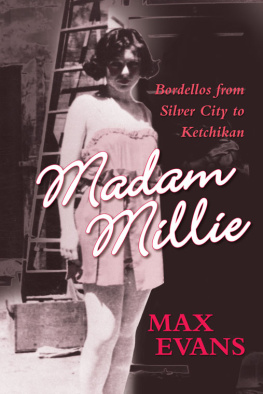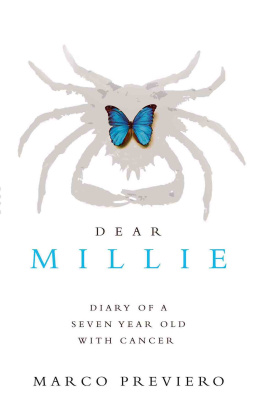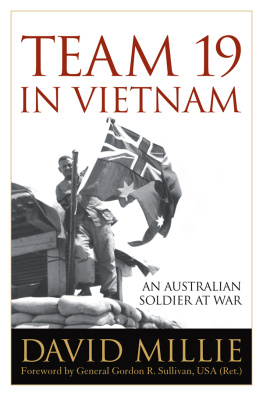ISBN for this digital edition: 978-0-8263-2784-0
2002 by Max Evans
All rights reserved.
First edition
The Library of Congress has cataloged the printed edition as follows:
Evans, Max, 1925
Madam Millie : bordellos from Silver City to Ketchikan / Max Evans. 1st ed.
p. cm.
ISBN 0-8263-2782-6 (cloth : alk. paper)
1. Cusey, Mildred Clark.
2. ProstitutesWest (U.S.)Biography.
3. BusinesswomenWest (U.S.)Biography. 4. ProstitutionWest (U.S.) I. Title.
HQ145.W47 E9 2002
306.742092dc21
2001006420
Preface: To the Life and Wild Times of Silver City Millie
I can almost hear her laughing as I write this. Her mirth was as infectious as a happy plague. It resonated into your being, and somehow you felt the triumphs dominating the enormity of the tragedies. Then, as Millie comes into focus, the eyes exude the joy of the ridiculousness of us all. There is no bitterness in that life-tested and physically battered face. It is the slightly crinkled face of a Munchkin with childlike smoothness still therethe face of a great survivor, which she certainly was. She was also, ultimately, a hell of a winner. Las Vegas odds-makers would run for cover here and make nothing but very quiet side bets.
Her often brutal honesty was almost always tempered by a humor that verged on both the slapstick and the sophisticated. The one exception being her older, invalid sister, Florence. Here, Millies voice and expression became both tender and somber at the same time. Her eyes looked at tears that flowed backward.
This was the most difficult book I have ever put together. No matter how I checked out some of the wild storieswild by their locale, time of occurrence and the nature of her businessthey were not only unutterably true, but actually understated in some cases. She did ask that I change a few (very few) names to protect the feelings of someone else besides herself. These changes are minor, however, and matter not one whit to her story of sacrifice, courage, and almost limitless fun.
I taped her conversations, made pages of notes, and wrote a great deal of this down, while she was still alive. I tried desperately not to let the I word interfere. It was a constant strain and struggle, but it seems that this has been achieved. I decided, however, that I would not do the usual afterword, but would instead call it, appropriately to the subject matter, Afterglow. Therein I could relate the adventures I had personally shared with Millie and her beloved third husband, Wendell Cusey.
I also felt strongly that by leaving her story in the present tense I could maintain the immediacy of her history exactly as I had listened, researched, and relaxed with the two of them. Now, as I put down the final words to this work, I feel it was the right decision. I will now hope for the near impossible: that the essence of her bravery, the dedication and suffering she afforded for those she loved, and above all that indomitable will to have a good laugh no matter where the stones fell, will be as indelible to the reader as they are to me. She is both a rising and setting sun in the cool blue mountains and the often searing, but also gloriously colored desert sky of the western half of our great land.
Max Evans
Albuquerque, New Mexico
Putting Millie in Her Place: Prostitution in the American West
An Introduction by Andrew Gulliford
The story of Silver City Millie is the story of one womans personal tragedies and triumphs as an orphan, a Harvey Girl waitress on the Santa Fe railroad, a prostitute with innumerable paramours, and a highly successful bordello businesswoman. Millie broke the mold in so many ways, and yet her lifes story of survival was not unlike that of thousands of women who went west only to find that their most valuable assets were their physical beauty and their personality. Petite at five feet tall and with piercing blue eyes, Millie captured mens attention by her very essence and her unmistakable joie de vivre.
Born to Italian immigrant parents in Kentucky, Millie and her sister Florence were orphaned early and separated from each other. Millie learned hard lessons on the streets, but she never gave up, and she vowed to protect and support her ailing older sister. Caught in a domestic squabble in her foster home, Millie wound up in juvenile court with Harry Truman as her judge. This was only the first of many brushes in her life with prominent politicians.
When physicians diagnosed her sister with tuberculosis and recommended she move out west to a Catholic home in Deming, New Mexico, Millie moved with her. Expenses ran high, and after a brief stint waiting tables as a Harvey Girl, Millie found that her meager tips could easily be augmented by turning tricks. Thus, out of financial need and devotion to her sister, Mildred Cusey turned to a life of prostitution and a career at which she soon excelled and became both rich and famous.
Madam Millie, the story of Silver City Millies life, contains sordid details and frank language that will make many readers blush. Before condemning her bawdy, drunken life, however, readers must become aware of the full context of prostitution in the American West. Prostitution was like motherhood and apple pie. It was expected, condoned, and appreciated, if segregated.
Women of the line, also known as soiled doves or fallen angels, followed the usual precepts in the West, which were all about resource exploitation and extraction. Cows ate grass (on public land); miners dug holes (on public land); woodcutters felled trees (on public land); farmers took up homesteads (on public land that then became private land after much labor and sacrifice); and some young women also used the resources they had available, which just happened to be their bodies. The resources they extracted came from the men in the form of gold, silver, and the occasional deed to mining claims.
The ratio of men to women in the frontier West was frequently seven to one. And in the absence of other diversions, the sporting culture of most mining camps and boomtowns meant getting drunk and visiting a house of ill repute. In Virginia City, Nevada, only months after the Washoe Rush, residents numbered 2,379 men and 147 women, which prompted a prospector poet to pen these lines:
Oh the lust for mountain gold dust,
Brought us lusty mountain men;
Who, through lust for mountin women
Quickly lost their gold again.
Across the West there are innumerable stories, some fact and some fiction, of the flourishing red-light districts, of madams who married well, of high-priced whores in fancy houses, and poor working girls in two-room cribs or living unprotected on the street.

Prostitution continues in the New West in parts of rural Nevada where the nineteenth-century custom of fancy parlor houses in business districts has given way to modern double-wide trailers out among the sagebrush. One wonders why Billie had to add the line Men only to her sign? Perhaps gender equity has yet to come to certain service industries in the Silver State. Photo by Andrew Gulliford, 1981.
Across most of the United States, the golden age of parlor houses extended from the 1870s to World War I, but in the West, prostitution remained legal for much longer: in Laramie, Wyoming, through the 1950s; and in Silver City, New Mexico, until the late 1960s, when the law finally closed Millies famous Hudson Street houses. Truly, Millie was the last of the frontier madams.









